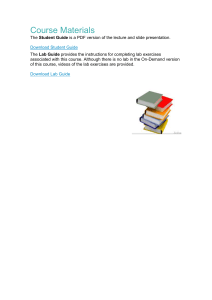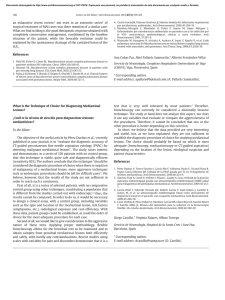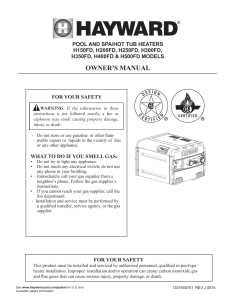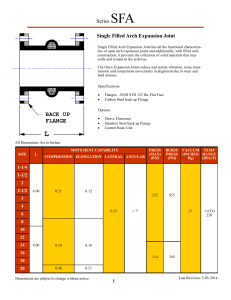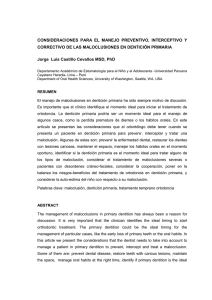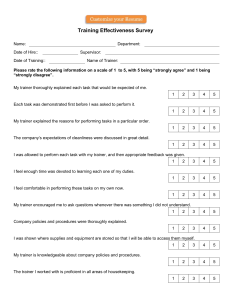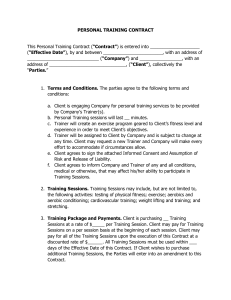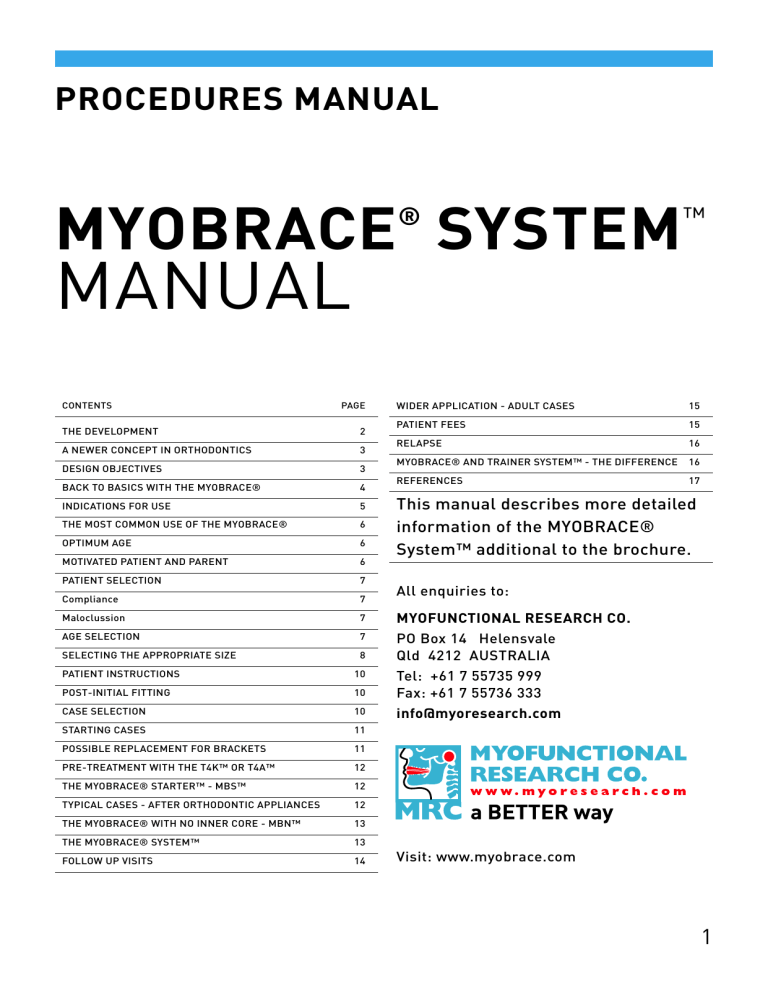
PROCEDURES MANUAL MYOBRACE SYSTEM ® ™ MANUAL CONTENTS PAGE WIDER APPLICATION - ADULT CASES 15 PATIENT FEES 15 RELAPSE 16 MYOBRACE® AND TRAINER SYSTEM™ - THE DIFFERENCE 16 REFERENCES 17 THE DEVELOPMENT 2 A NEWER CONCEPT IN ORTHODONTICS 3 DESIGN OBJECTIVES 3 BACK TO BASICS WITH THE MYOBRACE® 4 INDICATIONS FOR USE 5 THE MOST COMMON USE OF THE MYOBRACE® 6 OPTIMUM AGE 6 MOTIVATED PATIENT AND PARENT 6 PATIENT SELECTION 7 Compliance 7 Maloclussion 7 MYOFUNCTIONAL RESEARCH CO. AGE SELECTION 7 SELECTING THE APPROPRIATE SIZE 8 PO Box 14 Helensvale Qld 4212 AUSTRALIA This manual describes more detailed information of the MYOBRACE® System™ additional to the brochure. All enquiries to: PATIENT INSTRUCTIONS 10 POST-INITIAL FITTING 10 Tel: +61 7 55735 999 Fax: +61 7 55736 333 CASE SELECTION 10 [email protected] STARTING CASES 11 POSSIBLE REPLACEMENT FOR BRACKETS 11 PRE-TREATMENT WITH THE T4K™ OR T4A™ 12 THE MYOBRACE® STARTER™ - MBS™ 12 TYPICAL CASES - AFTER ORTHODONTIC APPLIANCES 12 THE MYOBRACE® WITH NO INNER CORE - MBN™ 13 THE MYOBRACE® SYSTEM™ 13 FOLLOW UP VISITS 14 Visit: www.myobrace.com 1 MYOBRACE® PROCEDURES MANUAL THE DEVELOPMENT Functional appliances and positioners have been in common use in orthodontics for as many years as orthodontics itself. Positioners are commonly used as pre-finishers or retainers and, more recently, as a complete orthodontic treatment for minor cases. Functional appliances, in particular, have a long history with good but unpredictable results. There are, however, still many practitioners in the orthodontic profession who dismiss the use of functional appliances entirely and use only fixed appliances. The 21st century trend towards the use of permanent fixed retainers would indicate that fixed appliance treatment has some deficiencies in the stability of the end result. It is worth revisiting the advantages and disadvantages of these removable systems and, with some development, these techniques should be reconsidered for treatment. In 1991, Myofunctional Research Co (MRC) introduced the preorthodontic TRAINER (T4K™). This was the first CAD prefabricated which was universally-sized (one size fits all) appliance in the world. It also incorporated into the appliance design, for the first time, myofunctional habit correction. This expanded to the “TRAINER System™” with T4B™ for use with brackets and the T4A™ for the use in the permanent dentition. Effectively, the system was designed for habit correction and also to provide some tooth-aligning properties. Although sharing some of the same features with its ancestors, the TRAINER System™ could not be defined as a positioner or as a functional appliance - it was a unique hybrid developed from these older systems. The principal concept was habit correction and dentalalignment became a secondary effect. The system has been very successful, particularly in early mixed-dentition, where the T4K™ has shown improvement in transverse arch expansion and class II correction (see research ref). In 2003, MRC researched the use of positioners and their effectiveness in dental alignment as an extension of the TRAINER System™ concept and, as a result, the MYOBRACE® was designed. The MYOBRACE® combines the positioner principles (mutiple sizes and tooth slots), improves it for better compliance and tooth alignment, and then adds what has been learned in the last decade from the TRAINER System™ about habit correction. The use of MRC’s patented dual-molding technology has made the MYOBRACE® a modern development of the functional appliance and positioner with real myofunctional habit correction. The potential to develop arch form without relapse for non-extraction orthodontic treatment with less use of “braces” has become a reality. 2 MYOBRACE® PROCEDURES MANUAL A NEWER CONCEPT IN ORTHODONTICS After introduction by Angle 100 years ago, through the technological age, multi-banded appliances still have many drawbacks. One of the major disadvantages is relapse - a problem which has plagued the orthodontic profession for decades and even more so today. The principal of moving teeth is well-known. Extractions do not help stability as Little has shown, but are introduced for the convenience of gaining space. When orthodontic principles are examined at a basic level, it is clear to see that there are alternative methods of achieving ideal dental alignment other than through the use of direct-bonded multi-bracket systems. The simultaneous correction of soft tissue habits like tongue-thrust and incorrect swallowing patterns has received renewed attention more recently. MRC has focused on this area for the last two decades, insisting that it is the key to improved stability. THE SIMULTANEOUS CORRECTION OF SOFT TISSUE HABITS LIKE TONGUE-THRUST AND INCORRECT SWALLOWING PATTERNS HAS RECEIVED RENEWED ATTENTION MORE RECENTLY. The current surge of interest in self-ligating brackets and the associated awareness of the role of the tongue, is a welcome trend in orthodontics. The MYOBRACE® is in keeping with this current trend. No extractions, less bracket time and far superior stability because of the active habit correction. NORMAL TONGUE POSITION DESIGN OBJECTIVES The dental and orthodontic professions are already familiar with prefabricated positioners with individual tooth slots, made to align or retain the teeth. These removable appliances, such as positioners, aligners, pre-moulded appliances and other various copies available, have demonstrated varying effectiveness. All of these traditional appliances have a limiting factor: their construction from one base material. The more rigid appliances made from hard PVC (such as the Occlusoguide and TP Positioner) are overly-hard and move teeth, but do not fit the mouth and lack comfort for the patient. An appliance made from a softer material (such as the MultiP) provides flexibility and comfort for the patient and adapts to more malocclusions but lacks sufficient force for arch development and dental-alignment. Neither materials have proven to be effective over a wide range of malocclusions. The MYOBRACE® uses a soft and flexible outer material, for the best comfort and adaptability to a wide range of malocclusions, with a harder nylon inner core for active treatment. Myofunctional training features which retrain the oral musculature are also provided. The result is a new appliance system that works over a wide range of malocclusions. It takes some extra knowledge to use the MYOBRACE® System™, particularly in case selection, but after some experience it will become much easier to select appropriate patients for optimum results. LOWERED TONGUE POSITION TONGUE THRUST SWALLOW 3 MYOBRACE® PROCEDURES MANUAL BACK TO BASICS WITH THE MYOBRACE® “The brackets and wire are fixed 24 hours a day to the teeth. How can something of intermittent wear two hours daily, plus night time have a significant influence on moving the teeth and treat soft tissue dysfunction?” This is a big concern for dentists. Scientific literature has demonstrated that the patient needs to wear the functional appliance for a brief time only during day-time to influence the muscles in such a way that the neuromuscular masticatory pattern is improved (Sander, 2001). Furthermore, three hours of continuous stimulation is enough to move the tooth in the periodontium and to produce alveolar bone remodeling (Roberts, 1997). Therefore, the intermittent use (usage for two hours daytime and overnight) recommended for the TRAINER System™ and the MYOBRACE®, deliver enough stimulus to move teeth and correct soft tissue dysfunction. The MYOBRACE® can be looked at from first principals of orthodontics - the DynaniCore™ (inner core) is the “wire” and the outer core engages the teeth like “the bracket”. The flexibility of the soft silicone outer makes for better adaption to the teeth, particularly if the teeth are badly aligned. The DynamiCore™ (inner core) is made from rigid nylon, which gives active arch expansion (mostly in the anterior region) and extra dental aligning forces equivalent to the function of arch wire. If the case is more severe and more flexibility is needed it is possible to start with the MBN™ - the MYOBRACE® without DynamiCore™. The MBN™ will provide less arch development and dental alignment forces, but better adaptability to more severe malocclusions, just like starting with the light and flexible arch wire of a fixed appliance (see section on page 12). If only arch expansion is needed, the MYOBRACE® Starter™ (MBS™) can be used. It does not exhibit tooth slots but does feature DynamiCore™ which is primarily used for arch expansion. If more than 10mm of expansion is required it is better to use a different arch expansion appliance such as the BWS™ or Quad Helix (see section on page 11). The pre-molded class I jaw position, like any positioner or functional appliance, gives class II correction if started early. (For Early Class III correction use the new Interceptive Class III - i3™ Appliance best for use between the ages of 6 - 8years). The added bonus of these appliances are the myofunctional features of the tongue tag and lip bumper to correct the habits causing the malocclusion and enhance class II correction. These have been incorporated into the MYOBRACE® from the TRAINER System™. Research on the TRAINER System™ now shows that it relocates the mandible (Usumez, 2004), expands arches, corrects class II and improves alignment in the majority of cases (Ramirez-Yañez, 2005a; Quadrelli, 2002). All of these characteristics have been incorporated into the MYOBRACE® System™. MYOBRACE® APPLIANCE MYOBRACE® APPLIANCE DYNAMICORE™ CUT-AWAY TRADITIONAL ORTHODONTICS 4 MYOBRACE® PROCEDURES MANUAL Many practitioners still do not accept the large role that the tongue and lips play in causing malocclusion. If this situation arises it is suggested that practitioners look at the soft tissue dysfunction section of the website - www.myoresearch.com to learn more about the major cause of orthodontic abnormalities. The information on this topic is overwhelming (Ramirez-Yañez, 2005b). The key issue over other systems is twofold. It is known that positioners and removable appliances can move teeth with this intermittent wear if used daily, on a regular basis. The MYOBRACE® has better compliance because of its dual-molding technology and, once removed, the tongue and the lips can continue alignment after treatment due to the unique myofunctional training characteristics of the MYOBRACE®. See the adjacent chart for tongue and lip forces. The constant reversion to no appliance in the mouth naturally develops a good functional occlusion and tooth position tends to follow lip and tongue function, uniquely setting teeth and muscle forces in harmony. Fixed appliances tend to force the teeth into a predetermined position, with the consequence that removal of the braces results in the teeth moving back to their original mal-position. This effect has been shown by many research papers over the last 50 years. THE REMOVAL OF FIXED APPLIANCES RESULTS IN THE TEETH MOVING BACK TO THEIR ORIGINAL MAL-POSITION. INDICATIONS FOR USE The guidelines that follow for patient selection are a starting point, as the criteria can be quite variable. It is important not to totally eliminate any patient from the potential of using the MYOBRACE® System™ but individual evaluation of patients is important. Most moderate malocclusions in the late-mixed or early-permanent dentition can be treated with the MYOBRACE®, provided that the appliance fits adequately into the mouth. There is a contra-indication for using the MYOBRACE® in more severe malocclusions merely because the appliance does not adequately fit into the mouth and therefore does not have control in improving dental-alignment. For severe malocclusions the MYOBRACE® with no inner core (MBN™) should be used. Without the DynamiCore™, the flexibility of the MYOBRACE® is increased and it becomes more adaptable to more severe maloclussions. The MYOBRACE® Starter™ (MBS™) is primarily only for arch expansion which is convenient if dental alignment is reasonable and the arches are merely narrow. This is particularly useful in some moderate class II div I cases. MYOBRACE® - MB™ - FOR MODERATE MALOCCLUSIONS IN THE LATE-MIXED OR EARLYPERMANENT DENTITION MBN™ - WITH NO INNER CORE FOR SEVERE MALOCCLUSIONS. THE STARTER - MBS™ PRIMARILY FOR ARCH EXPANSION WHICH IS CONVENIENT IF DENTAL ALIGNMENT IS REASONABLE AND THE ARCHES ARE MERELY NARROW. 5 MYOBRACE® PROCEDURES MANUAL COMBINED USE: THE MOST COMMON USE OF THE MYOBRACE® The most common use of the MYOBRACE® System™ is the combined use of the regular MYOBRACE® for two hours during the day and the MBN™ for nighttime use. This combination is generally used for the first six months of treatment when the night treatment is substituted for the regular MYOBRACE® with DynamiCore™. REGULAR MYOBRACE® - MB™ TWO HOURS DURING THE DAY OPTIMUM AGE The indicated optimum cases for use of the MYOBRACE® System™ is the late-mixed dentition stage between the ages of 8 - 12 years. As with any positioner-type appliance, eruption of the permanent dentition is an ideal time to change arch form and anterior dental alignment as the dentition is more dynamic. The MYOBRACE® is less effective once the permanent dentition has erupted, but can still be effective provided there is compensation in increased patient motivation and compliance. In the initial stages of practise it is best to select patients in this window of late-mixed dentition stage as well as patients who are motivated to obtain a result. MBN™ AT NIGHT WHEN ASLEEP MOTIVATED PATIENT AND PARENT There are two basic essentials in selecting patients: 1. The patient must be motivated. 2. The MYOBRACE® must fit reasonably well into the mouth at the first visit. Probably the most important factor for use of the MYOBRACE® is the motivation of the patient and the parent. If there is not regular consistent use of the system, there will be little or no result. With persistent and constant use, virtually any malocclusion will be improved by using the MYOBRACE® System™. SUITABLE FOR NON-EXTRACTION TECHNIQUES ONLY If there is a severe open bite or severe class II, the most suitable treatment may be the TRAINER System™ which has greater flexibility when combined with other orthodontic treatment (such BWS™, Quad Helix or transverse appliances). Class III treatment is better not treated with the MYOBRACE® but with the new i-3™ from MRC. 6 MYOBRACE® PROCEDURES MANUAL PATIENT SELECTION There are two components to patient selection - the degree of compliance and the severity of the malocclusion. 15+ Compliance The most important component is to select motivated patients and parents. The motivation to use the MYOBRACE® regularly is the basis in obtaining good results. If the patient is motivated to get a result without the use of brackets, or with very minimal time with braces, and also is well-organized, this will be an ideal starting point for a good result. FIXED APPLIANCES 12 to 15 Malocclusion Cases with mild to moderate maloclussion should be selected. The MYOBRACE® needs to fit the patient reasonably well from the commencement of treatment otherwise the teeth will not engage the tooth slots of the appliance. For this reason it is important to first evaluate each case by taking records with models and photos prior to setting a treatment plan involving the MYOBRACE®. Generally, 4 - 6mm of crowding and 4 - 6mm of overjet would be the limit of the MYOBRACE® System™ prior to gaining more experience with more severe cases. More severe malocclusions do not allow the MYOBRACE® to engage the teeth and will therefore prevent it from working properly. It is not recommended to treat class III cases with the MYOBRACE® System™. MRC has developed the i3™ for this purpose. For further information visit www.myoresearch.com. FIXED APPLIANCES 8 to 12 AGE SELECTION The MYOBRACE® can be used at any age – mixed or permanent dentition but the ideal age is during the eruptive and growth period in the late-mixed dentition. 6 to 8 The longer the permanent dentition is in place, the less effective the MYOBRACE® will be. Factors such as compliance, the degree of myofunctional correction required and degree of malocclusion all have an influence. The application of the MYOBRACE® will always improve dental alignment and treat myofunctional habits at any stage of development and therefore, just as in all orthodontic treatment, individual assessment is necessary. It is best to apply the MYOBRACE® in late-mixed dentition cases 7 MYOBRACE® PROCEDURES MANUAL either by itself in the first instance or after arch development with the TRAINER System™ and BWS™ (see section on page 11). Note: With the active arch development of DynamiCore™ practitioners are finding that exceptionally good anterior arch development is achieved. As with any arch expansion, some level of bite opening occurs. This is easily controlled in the late mixed dentition stage and can be quite beneficial in deep bite cases. In cases of permanent dentition a close watch should to be kept on the bite opening to ensure it does not become excessive. If an open bite becomes a result of treatment, stop the use of the MYOBRACE® for a period of one to two months and continue treatment only once normal occlusion is achieved. Use the T4A™ to close the bite in those rare cases where the open bite does not respond to removal of the MYOBRACE® for two months. On the positive side, much more permanent and stable results are achieved with the MYOBRACE® than with fixed braces. ARCH DEVELOPMENT BWS™ WITH DYNAMICORE™ SELECTING THE APPROPRIATE SIZE The appropriately-sized MYOBRACE® is selected by measuring across the four upper incisors. The size is based on the combined width of the upper incisors. This proportionately gives the correct size for the lower anterior and the arch form. If there is spacing or crowding the dimension does not alter, as the reference is the size of the teeth, not their positioning. Alternatively, when there is severe crowding or IF OVERCORRECTION OCCURS, USE THE T4A™ AS A RETAINER ���������������� MB4 MEASURING THE WIDTH OF THE 4 UPPER INCISORS ���������������� 8 MYOBRACE® PROCEDURES MANUAL spacing and it is difficult to obtain the measurement with the ruler, the individual four upper incisors can be measured and the measurements added together. This dimension is then compared with the size chart and the correct size can be determined. SIZE 1-2 WHITE INNER If a patient’s measurements fall between two sizes it is best to choose the larger size. The MYOBRACE® and MBN™ are available in seven individual sizes, which cover the majority of everyday cases. In designing the MYOBRACE® the uncommonly used very small and very large sizes have been eliminated. Due to the flexibility of the outer core of the MYOBRACE® and the design of the tooth slots, the size is not critical. After fitting, the appliance should be checked to ensure that the centre line is correctly aligned and the upper canine slots align with the patient’s upper canine area. It should also be checked that the patient can fully close into the MYOBRACE®. For instance, if the patient has a slight open bite the use of the MYOBRACE® may be contra-indicated as the anterior teeth will not engage the tooth slots. The most appropriate treatment with the MYOBRACE® System™ is to issue the patient with the appropriate size of MYOBRACE® with DynamiCore™ for wearing a minimum of two hours each day, and the MBN™ to use overnight. This gives optimum adaptability at night for comfort while sleeping in conjunction with myofunctional training. The regular MYOBRACE® during the day imparts more force on the teeth and the arch form and provides adequate arch expansion and positive forces to align the anterior dentition for the first six months. After this time the MBN™ can be phased-out and replaced by the regular MYOBRACE® with DynamiCore™. SIZE 3-4 BLUE INNER SIZE 5-7 DARK BLUE CHECK THAT THE CENTRELINE OF THE MYOBRACE® IS ALIGNED AT THE DENTAL CENTRELINE, AND THE CANINE SPACE IN THE MYOBRACE® ALIGNS WITH THE CANINE POSITION EVEN IF UNERUPTED. IF NOT, SELECT A DIFFERENT SIZE. 9 MYOBRACE® PROCEDURES MANUAL PATIENT INSTRUCTIONS It is important to properly instruct the patient that the MYOBRACE® must be used for a minimum of two hours per day plus overnight. This must be done on a daily basis or the treatment will not work. The patient should be informed that treatment will need to be suspended if compliance is not acceptable. Conversely, the MYOBRACE® is a powerful myofunctional and arch expansion appliance and patients should also be advised that excessive use for more than four hours per day can cause excessive and undesirable tooth movement. The DynamiCore™ is active at all times and therefore, like arch wire, is causing some tooth movement while in place. Once the correct result has been achieved, it is best to decrease or stop the day time use or suspend treatment and observe the stability of the result. Use of the T4A™ at the end of treatment is recommended if a retainer is required. 7 August 2004 USE FOR A MINIMUM OF TWO HOURS PER DAY PLUS OVERNIGHT. POST-INITIAL FITTING After the appliance is fitted, it is important to establish routine reviews to assist in ensuring that treatment is proceeding correctly. Regular reviews once every one to two months are important to ensure that the active treatment is progressing as planned. Soft tissue and dental changes should be seen in the first two to three months. Regular evaluation of treatment progress is important as dental changes can be much more rapid than expected. Progressive models and photos should be taken at three-monthly intervals to record and measure progress. Patients should not be sent away for extended periods of use with the MYOBRACE® without close monitoring as the MYOBRACE® may “over-treat” to an undesirable result. The patient should be informed that it is essential to have these regular reviews for this reason. The patient should be charged on each of these visits and cost of these visits should be factored into the treatment plan fees. THIS MUST BE DONE ON A DAILY BASIS OR THE TREATMENT WILL NOT WORK. THE PATIENT SHOULD BE INFORMED THAT TREATMENT WILL NEED TO BE SUSPENDED IF COMPLIANCE IS NOT ACCEPTABLE. 22 November 2005 Generally, treatment time is between 12 – 18 months. Once a good result is achieved, the T4A™ should be used as a retainer. CASE SELECTION The MYOBRACE® brochure, CD and website describe some minimum requirements as a starting point for treatment with the MYOBRACE®, but they are merely guidelines. The treatment of mild to moderate malocclusion with 4-6mm of crowding, and less that 5mm of overjet in class II cases is a parameter for starting cases. It should be kept in mind that the MYOBRACE® is working at a myofunctional level as well as an orthodontic level. The patient may achieve some improvement of severe malocclusion, certainly in the arch form, just by the correction of myofunctional habits. IT IS IMPORTANT TO GIVE EVERY PATIENT THE CHOICE OF THE MYOBRACE® SUITABLE FOR NON-EXTRACTION TECHNIQUES ONLY 10 MYOBRACE® PROCEDURES MANUAL STARTING CASES The easiest cases to start are those with mild crowding of the upper and lower anterior with moderately narrow arch form. In addition to this, the MYOBRACE® brochure shows the ideal adaptation to postarch development using either the Bent Wire System™ (BWS™), Quad Helix or conventional transverse appliances to maintain the arch form while correcting the dental alignment once all of the teeth have been moved. As shown with the TRAINER System™ and the MYOBRACE® brochures, this can greatly assist in the correction of class II. INFORMED CONSENT PATIENTS ALWAYS NEED TO BE INFORMED OF THE RISKS ASSOCIATED WITH FIXED APPLIANCES. POSSIBLE REPLACEMENT FOR BRACKETS In many cases, particularly if the MYOBRACE® is used in the optimum mixed dentition stage, the necessity for braces is greatly reduced or even eliminated. The opportunity to use a limited amount of fixed appliances for ultimate fine-tuning of the dentition is not lost in this timing. For instance, if patient compliance is not as good as expected when the permanent dentition fully erupts into position, fixed appliances can still be used partially and for limited amounts of time to align the anterior teeth. Class II correction and arch development would have been obtained along with dental alignment which minimizes fixed appliance treatment time. This is particularly useful if the patient also has poor oral hygiene, which is a contra-indication for prolonged fixed appliance treatment. THE MYOBRACE® DOES NOT HAVE THESE RISKS, AND SHOULD BE OFFERED TO PATIENTS AS A CHOICE. ZERO BRACES ORTHODONTIC TECHNIQUE ARCH DEVELOPMENT FOLLOWED BY THE MYOBRACE™ CROWDING CLASS II 1 START OF TREATMENT TYPICAL CASE SELECTION TYPICAL CASE SELECTION ≥ 3 AUGUST 2004 2 BENT WIRE SYSTEM TREATMENT COMPLETE 3 AFTER SIX WEEKS OF DAILY MYOBRACE™ USE. ≥ 8 FEBRUARY 2005 ≥ 22 MARCH 2005 ≥ 8 FEBRUARY 2005 ≥ 22 MARCH 2005 START ≥ 3 AUGUST 2004 11 MYOBRACE® PROCEDURES MANUAL PRE-TREATMENT WITH THE T4K™ OR T4A™ Like most positioners, and unlike the TRAINER System™, the MYOBRACE® has a relatively thick base (because of the inner core - DynamiCore™) which, with some malocclusions, can make it difficult for the patient to keep their lips together. This is one of the contraindications of using the appliance and those familiar with the TRAINER System™ will readily recognize that pre-treatment with the preorthodontic TRAINER T4K™ can greatly assist in these situations to prepare the case for the MYOBRACE® System™. PRE-ORTHODONTIC TRAINER - T4K™ THE MYOBRACE® STARTER™ - MBS™ The MBS™ makes the MYOBRACE® a stand alone system – one able to treat the majority of crowding, Class II, and open bite cases. The use of brackets to do some final alignment is also possible. If cases are too severe to begin with the MYOBRACE® MB™ (With DynamiCore™), a variation has been developed: the MYOBRACE® Starter™ (MBS™). The tooth slots (and therefore sizes) have been eliminated, and the inner core softened to give more flexibility. Two inner cores (DynamiCore™) are available: MYOBRACE® STARTER™ MBS™ - WITH DYNAMICORE™ NO TOOTH SLOTS 21 JUNE 2005 Blue (soft - phase I) and Red (hard - phase II) for those Doctors familiar with the TRAINER System™, the MBS™ is like a T4K™ with the added active arch development of DynamiCore™. TYPICAL CASES USING THE MYOBRACE® AFTER ORTHODONTIC APPLIANCE SYSTEMS The MYOBRACE® comes with a built-in arch expander – DynamiCore™. Unlike the TRAINER System™, the MYOBRACE® is not suitable for use with arch expansion appliances like Quad Helix or Bent Wire System™ (BWS™). It is, however, great to use after these appliances if maintenance of substantial expansion or correction of anterior alignment is required. With the built-in DynamiCore™ some posterior cross bite corrections can be obtained with good compliance. If the patient has a severe posterior cross bite, it is preferable to correct this first with some form of arch development. Visit www.myoresearch.com to find out more about the Bent Wire System™ (BWS™) to see exactly how this can be used in conjunction with the TRAINER System™. Effectively, the MYOBRACE® is an arch expander as well as a ARCH EXPANSION WITH THE BENT WIRE SYSTEM - BWS™ 13 MARCH 2006 BUILT-IN ARCH EXPANDER - DYNAMICORE™ FROM MYOBRACE® MB™ 12 MYOBRACE® PROCEDURES MANUAL positioner, but if considerable amounts of arch development are needed, more powerful transverse arch expanders are recommended. INTRODUCING THE MYOBRACE® WITH NO INNER CORE – MBN™ One limitation of the MYOBRACE®, with its tooth slots and hard inner core, is that it does not always fit the patient well at the beginning of treatment when the malocclusion is most severe. This is normal and a common problem with regular positioner appliances. MYOBRACE® WITHOUT DYNAMICORE™ - MBN™ MBS™ For this application MRC has introduced the MYOBRACE® with no inner core – MBN™ for use at night at the start of treatment combined with the regular MYOBRACE® for two hours daytime use. The MBN™ has no inner DynamiCore™, which makes it more flexible and more adaptable to a wider range of more severe malocclusions. As explained previously, this has become the most common starting procedure with the MYOBRACE® System™, and this combination with myofunctional correction has produced outstanding anterior arch development, class II correction and exceptional stability. The use of two appliances increases the perceived value to the patient and extends the durability of the MYOBRACE® with DynamiCore™. MB™ WITHOUT Dynamicore™ there is better flexibility to adapt to more severe malocclusions. THE MYOBRACE® SYSTEM™ MBN™ MYOBRACE® STARTER™ - MBS™ With DynamiCore™ (Inner Core), but NO tooth slots. Two phase appliance - Soft (Blue) and Hard (Red), no sizes. Wider adaptability for starting cases and good arch development. MYOBRACE® REGULAR™ - MB™ With tooth slots and DynamiCore™ (Inner core). 7 sizes. Optimum dental aligment and arch development in late mixed and early permanent dentition. MYOBRACE® NO INNER CORE™ - MBN™ With Tooth slots, but NO DynamiCore™. 7 sizes. Maximum flexibility, best for more severe cases, patient comfort and good dental alignment. MYOBRACE® KIT 13 MYOBRACE® PROCEDURES MANUAL FOLLOW UP VISITS The MYOBRACE® is a complete orthodontic system capable of not only moving teeth but also improving arch form, AP relationship, facial form and TMJ health. These cases need to be treated like any other orthodontic case. The usual records for orthodontic treatment procedures are requitrf. Models, photos and x-rays should be taken for doctor records and a patient presentation should be given on the second visit. Once the MYOBRACE® is the preferred treatment the patient should be given clear instructions on the timing and the importance of maximum compliance. The patient should be monitored closely and charged appropriately. At each follow up visit, at one to two month intervals, it is important to first confirm that compliance has been good. Experience with diaries and other notational devices shows that children either do not bring them along or do not fill them out at all. It is therefore better to put the question to the parent as to whether the patient has fallen into a routine of regular use of the MYOBRACE®. The MYOBRACE® can be checked for signs of wear. It there is no sign of wear, it may be a sign that compliance should be improved. Progress should be observed by noting soft tissue changes, improved situation with open-mouth posture, improved dental alignment and class II correction, if appropriate. It is advisable to measure changes in arch width in the inter-molar and inter-canine area. This can also be confirmed by periodical taking of models. Progress photos are important to motivate the patient on the progress and reinforce continued compliance. FOLLOW UP VISITS CHECK FOR IMPROVED LIP POSTURE It is important to check that the MYOBRACE® is being worn correctly at each follow-up visit by asking the patient to put the appliance in their mouth. This will also identify whether compliance is good as the MYOBRACE® should be very easily accepted by the soft tissue. Patients should be advised that it is normal for the appliance to fall out during sleep and that this is an indication that more perseverance is needed. The MYOBRACE® is a system that may require replacement of the appliance as it gets worn out. Six months is the average life-span of the silicone. If the appliance is chewed on heavily, particularly at night, wear will be increased and splitting will occur. In this instance the patient should be issued with a new appliane and charged accordingly. If starting with a MYOBRACE® and MBN™ combination as indicated then the wear factor on the MYOBRACE® is less than it would be with a singular appliance. This will mean that the treatment usually progresses without excessive wear or splitting of either MYOBRACE®. However, with extended use or excessive chewing of the MYOBRACE®, some splitting or staining of the MYOBRACE® may also occur. In both cases it is appropriate to replace the MYOBRACE® with a new one. Patient fees should be estimated to cover these replacements, which must be anticipated in most treatment plans. Not dissimilar AFTER 3–4 MONTHS LIPS SHOULD CLOSE AT REST GOOD LIP POSTURE AFTER 6-12 MONTHS OF REGULAR USE 14 MYOBRACE® PROCEDURES MANUAL to high performance tyres on a car, longevity is not as important as performance. The MYOBRACE® performs well but often needs to be replaced for continued active treatment. Note that with correct wear, the MYOBRACE® will wear and split after some months. This is an indication that compliance is good and the parent should be informed that there will be continuing charges for additional replacement appliances. WIDER APPLICATION PERMANENT DENTITION – ADULT CASES The MYOBRACE® can be used by adults as well as children, as with the T4A™ in the TRAINER System™. The effectiveness of the appliances is more variable but it tends to be the case that adults are more reliable in compliance and therefore compensates for the fact that the teeth do not move as readily as a child’s and the bone is less adaptable. These cases are often just as effective as with younger patients because the motivation is much higher. As stated earlier, motivation is a key factor and is also a variable. High motivation and use can compensate for other difficulties with the treatment but adult cases can be less predictable in outcome. PATIENT FEES Practitioners often have trouble on how to bill for treatment with pre-fabricated appliances. Generally, the patient does not have this problem with orthodontic and alternative treatment without brackets because it is well-known that these treatments are all expensive. The MYOBRACE® is very cost effective to patients and a fee of 50%-70% of the regular orthodontic fixed appliance fee is appropriate. It is important to understand that the patient perception of value is what the appliance system can do. The MYOBRACE® certainly can do every bit (plus more) than conventional fixed braces. ENSURE YOUR CHARGES ARE ADEQUATE AND EXPLAINED TO THE PARENT PRIOR TO COMMENCEMENT OF TREATMENT. FACTOR IN THE COST OF MODELS, PHOTOGRAPHS THROUGHOUT THE TREATMENT AS WELL AS THE POSSIBILITY OF REPLACEMENT OF THE MYOBRACE® IF SPLITTING AND WEAR OCCURS. START WITH MB™ DURING DAY TIME AND MBN™ AT NIGHT FOR 3 MONTHS 15+ FIXED APPLIANCES A FEE OF 50%-70% OF THE REGULAR ORTHODONTIC FIXED APPLIANCE FEE IS APPROPRIATE. FIXED APPLIANCES WITH CORRECT WEAR, THE MYOBRACE® WILL SPLIT AFTER SOME MONTHS. THE PARENT SHOULD BE INFORMED THAT THERE WILL BE CONTINUING CHARGES FOR ADDITIONAL REPLACEMENT APPLIANCES. 15 MYOBRACE® PROCEDURES MANUAL RELAPSE There are many stories that parents can tell of relapse after orthodontic treatment. The fact that the MYOBRACE® treats one of the major causes of relapse, the untreated myofunctional habits, gives great potential to exceed the rather poor long term results of fixed brackets in terms of requiring long term retention. It is important to explain the purpose of the treatment. With good compliance a dissatisfied patient and parent will be rare. The majority of the cases, patient and parent expectations are exceeded by the treatment because there are no brackets and the treatment is very non-intrusive. Patients prefer a more natural, less invasive, and less painful approach. This is provided by treatment with the MYOBRACE® and the fee often becomes irrelevant. THE MYOBRACE® IS AN IDEAL TREATMENT WHEN RELAPSE HAS OCCURRED AFTER FIXED APPLIANCE TREATMENT. AVOID REBANDS WITH THE MYOBRACE® WHAT IS THE DIFFERENCE BETWEEN THE MYOBRACE® SYSTEM™ AND THE TRAINER SYSTEM™ Both systems originate from MRC’s advanced technology in intra oral design. The systems are similar and complimentary rather than a replacement of one for the other. The TRAINER System™ is primarily for habit correction before, during and after orthodontic treatment and will also fit most malocclusions. Facial development is a primary goal of the pre-orthodontic TRAINER T4K™. One other major difference is that the TRAINER System™ is used as myofunctional habit correction in conjunction with almost any form of orthodontic treatment. The MYOBRACE® System™, on the other hand, is a stand-alone system. It requires more thorough case selection than for the TRAINER System™, it will not fit all malocclusions but will perform a moderate amount of arch development. If considerable arch expansion is required, the T4K™, Bent Wire System™ or transverse expansion should be used first. The MYOBRACE® is primarily for dental alignment and is an alternative to conventional fixed appliances in the late mixed dentition stage. Just as with fixed appliances, where considerable arch length or arch expansion is needed, some phase 1 treatment prior to fitting the brackets should be used. The MYOBRACE® is similar in its function. Its DynamiCore™ is designed to perform a level of arch development and a considerable amount of dental alignment but not to extreme lengths. It may become apparent that the MYOBRACE® does not fit into the mouth in cases of severe mis-alignment . This is the criteria. The dual-molding and construction of the MYOBRACE® also makes it more expensive compared with single-moulded TRAINER System™. More information on cases, questions and answers and lecture updates will be available on the MYOBRACE® web site. Get started and share you knowledge at www.myobrace.com. MYOBRACE® & T4K™ CROSS SECTIONS T4K™ APPLIANCE MYOBRACE® STARTER™ DYNAMICORE™ AND NO TOOTH SLOTS 16 MYOBRACE® PROCEDURES MANUAL REFERENCES Quadrelli C, Gheorgiu M, Marchetti C, Ghiglione V (2002). Early myofunctional approach to skeletal Class II. Mondo Orthod 2:109-122. Ramirez-Yañez, GO, Junior E, Sidlauskas A, Flutter J, Farell C (2005a) Dimensional changes in the dental arches after using a prefabricated functional appliance. J Clin Orthod (in submission). Ramirez-Yañez GO, Farrell C (2005b). Soft Tissue Dysfunction: A missing clue when treating malocclusions. Int J Jaw Func Orthop (in press). Roberts WE, Hohlt WF, Arbuckle GR (1997). The supporting structures and dental adaptation. In: Science and practice of occlusion. McNeill C (Ed). Quintessence, Chicago, pp: 79-92. Weiland, F (2003). Constant versus dissipating forces in orthodontics: the effect of initial tooth movements and root resorption. European Journal of Orthodontics 2003;25:335-42. Sander FG (2001). Functional processes when wearing the SII appliance during the day. J Orofac Orthop 62:264-74. Usumez S, Uysal T, Sari Z, Basciftci FA, Karaman AI, Guray E (2004). The effects of early preorthodontic Trainer treatment on Class II, division 1 patients. Angle Orthod 74:605-9. The MYOBRACE® is a new development in orthodontic treatment based on the time proven principles of the positioner concept. This intra-oral appliance features individually-sized tooth slots and DynamiCore™, the active inner core enabling controlled arch development. Incorporating the very latest CAD and dual moulding technology pioneered by Myofunctional Research Co, the MYOBRACE® features high-tech design characteristics to align the anterior dentition and the mandible into Class I. The MYOBRACE® is suitable for most children currently in the mixed or permanent dentition with mild to moderate malocclusions. MYOFUNCTIONAL RESEARCH CO. PO Box 14 Helensvale Qld 4212 AUSTRALIA Tel: +61 7 55735 999 Fax: +61 7 55736 333 [email protected] www.myobrace.com 17
